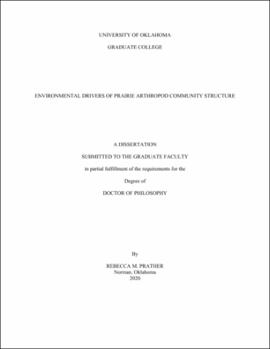| dc.description.abstract | Global climate change—including increased temperature, altered precipitation patterns, and nutrient deposition—may reshape plant–arthropod relationships. Arthropods comprise the majority of animal biodiversity on Earth and provide critical ecosystem services. Thus, understanding arthropod responses to multiple climate-change stressors is an important step towards maintaining healthy ecosystems. This is especially true in natural grasslands, a habitat covering 37% of the Earth’s land surface but rapidly shrinking due to anthropogenic impacts. In my dissertation I explore the effects of changing environments on plant communities and how those factors affect insect food choice and the long-term maintenance of grassland arthropod communities.
In chapter one, I explore how seasonal and diel temperature change shapes the foraging rate and demand for two resources, salt and sugar, in a grassland ant community. Across seven months, I found that recruitment to salt, but not sugar, accelerated with temperature. In ectotherms like ants, sugar is stored in cells and sodium is pumped out of cells proportional to temperature. A three-month follow up experiment verified that temperature-dependent recruitment to sugar concentrations of 20% (mimicking rich extrafloral nectaries), was half as temperature-dependent as recruitment to salt. Combined, I demonstrate how ecosystem warming accelerates the work done by a community of ectotherms, and how the demand and use of fundamental nutrients can be differentially temperature dependent.
In chapter two, I focus on how plants regulate grassland arthropod abundance and diversity via biotic and abiotic factors. I factorially combined three clipping treatments with NPK fertilization to manipulate plant biomass, plant quality, and habitat heterogeneity. Clipping raised surface temperature and simplified habitat structure. Together, this decreased arthropod abundance and diversity while increasing arthropod activity. Fertilization mediated the reduction in arthropod abundance and diversity by increasing plant quality and plant biomass which indirectly decreased surface temperature. By itself, fertilization increased arthropod abundance, activity, and richness. Altogether, changing microclimate, plant quality, and plant biomass shifted arthropod community composition toward more diverse communities, demonstrating the importance of habitat heterogeneity and plant quality in structuring grassland arthropod community composition.
In chapter three, I explore how altered precipitation regimes and anthropogenic disturbances may change plant–arthropod relationships in grasslands. I used an experimental precipitation gradient combined with human management to examine: (1) how altered precipitation and biomass removal synergistically affect abiotic factors and plant communities and (2) how these effects cascade upward, impacting the arthropod food web. Both drought and hay harvest increased soil surface temperature while drought, but not hay harvest decreased soil moisture. Arthropod abundance decreased with low soil moisture and, contrary to my predictions, decreased with increased plant biomass. Arthropod diversity tracked arthropod abundance but was unaffected by plant diversity or quality. Combined, I show arthropod abundance is directly controlled by abiotic factors and plant biomass, in turn constraining local arthropod diversity. If robust, this result suggests climate change in the southern Great Plains may directly reduce arthropod diversity.
In chapter four, I investigate the effects of anthropogenic nutrient deposition on grassland food webs. I used a fertilization gradient to track nutrient addition through a food web, measuring changes to soil and plant fertility, plant and arthropod communities, and ultimately, herbivory. Using a multi-year experiment, I tested the mechanisms driving herbivory within and across fertilizer quantities and durations. Fertilization increased soil fertility 100-fold and generated a 1.3-fold increase in herbivory. This herbivory increase weakened over time—from a 1-year pulse experiment to a 2-year press experiment—as herbivory damage shifted from sucking herbivores (e.g., aphids) to chewing herbivores (e.g., grasshoppers). Overall, I found the rather paradoxical result that fertilization increased herbivore abundance but decreased herbivory. Combined, I demonstrate the rippling effects of changing soil fertility on the abundance and function of a prairie food web, predicting herbivore abundance and herbivory. | en_US |

